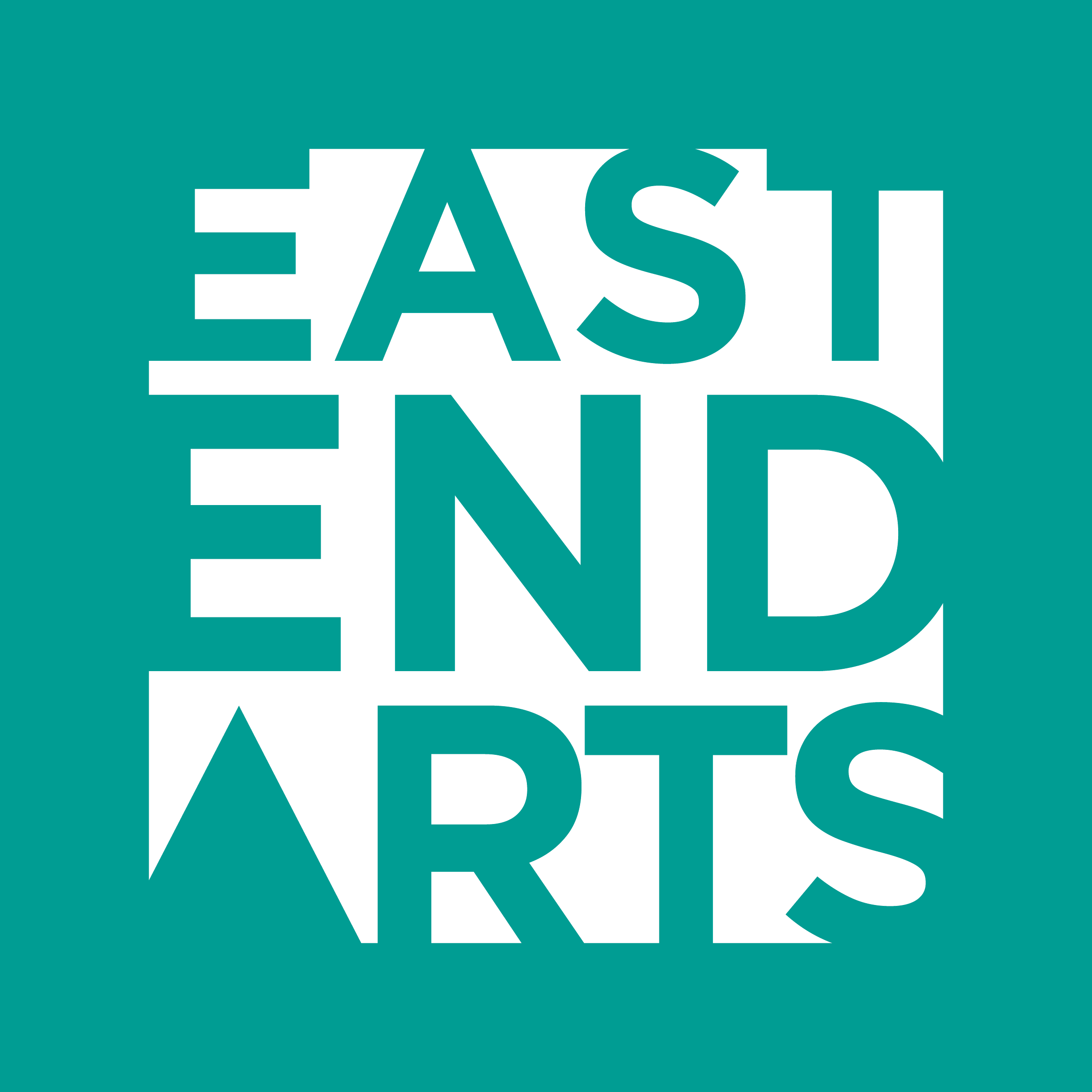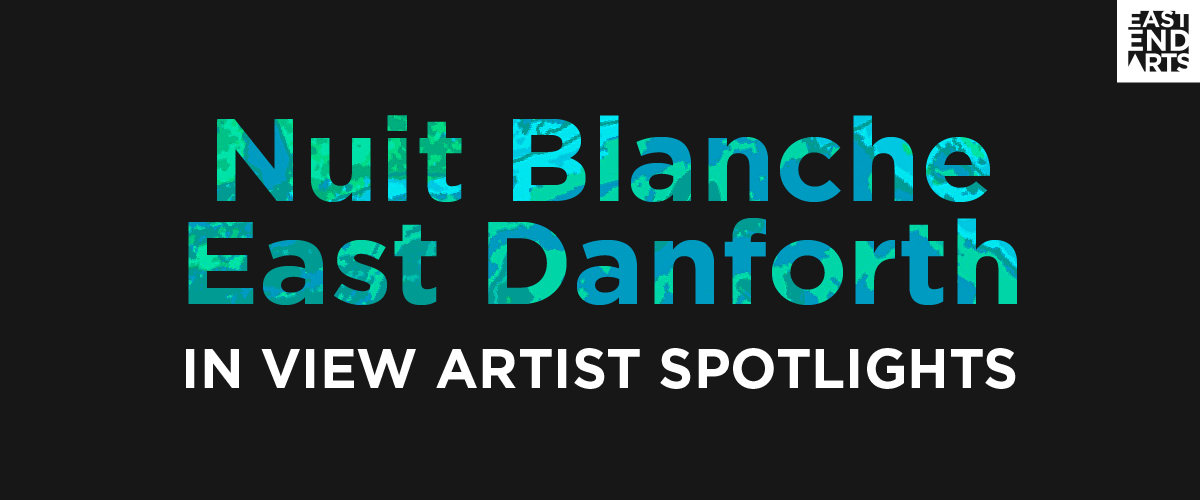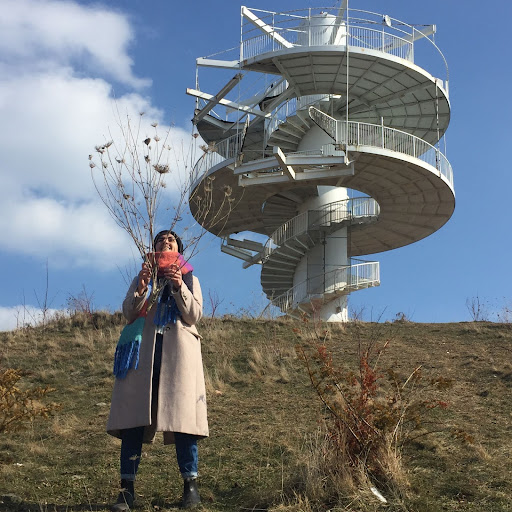East End Spotlight is a monthly news piece where we highlight a series of east end artists, arts organizations, creative spaces & professionals that we want to shine a spotlight on💙!
This month we are spotlighting the 20 amazing artists who are presenting their art in IN VIEW for Nuit Blanche East Danforth 2022. IN VIEW pairs local business owners with artists from across the city to transform storefront windows into exciting gallery displays. For the night of October 1st, 2022, twenty independent artists will bring storefront windows and outdoor spaces to life along Danforth Avenue. We asked each artist to reflect on this year’s theme: The Space Beneath Us. Read on to hear about their art, check them out on social media, and hear about what The Space Beneath Us means to them!
- Asli Alin
- Stephanie Avery
- Natalie Very B.
- Trotter Brothers
- Vridhhi Chaudry
- Steph Cloutier
- Monica Gutierrez
- Sarah Imirsek
- Andria Keen
- Noor Khan
- Nancy Lalicon
- Jungle Ling
- Marzieh M. Miri
- Erin Poole
- Naz Rahbar
- Sarvenaz Rayati
- Riya Razhan & Zen Alladina
- Tennesha Skyers
- Sara Vargas Nessi
- Jes Young
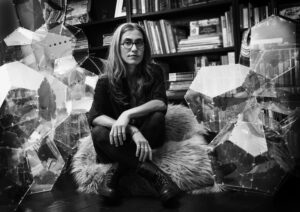 Asli Alin
Asli Alin
Instagram | Website
IN VIEW Installation: Elestial Lace
About the Artist: Asli Alin (she/her) is a multidisciplinary artist traversing disciplines of painting, installation and photography who holds a Bachelor of Landscape Architecture. Alin`s sculptural work has received tremendous interest over the past two years, and has been invited to participate at festivals such as Nuit Blanche Toronto, Supercrawl (Hamilton, ON), Nuit Blanche North (Huntsville ON) and Lumen Festival (Waterloo, ON). In addition to her sculptural work, Asli is also frequently commissioned by corporations and municipalities to create murals in both digital and analogue format. Asli lives and works in Toronto.
Tell us how you relate to the theme “The Space Beneath Us”: Either a story of home, what wilderness means to you, about a memory that effects your/your art to this day, or a little about your roots and just how deep they can grow.
As an immigrant in this land, I am slowly making some room for my roots to grow, but it takes a long time. I feel like for most adult immigrants, growing new roots/connections in the new land is not a natural process that happens on its own. It takes a considerable amount of time, a conscious effort, and probably a lot of ambition. This is particularly true if there is a language barrier. Imagine if you had to remember to blink, breathe, and beat your own heart at the same time. You would have so much to do, before even catching up with someone who never has to think about these.
Stephanie Avery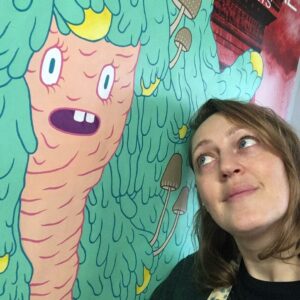
Instagram | TikTok | Website
IN VIEW Installation: Buried Pleasures
About the Artist: Stephanie Avery (she/her) is a Toronto-based multi-disciplinary artist with a degree in visual art from York University. With an emphasis on interactivity and empowerment, Stephanie’s practice intervenes with familiar spaces, objects and imagery to imbue her subjects with new meanings and narratives. Being especially interested in our collective relationships to the spaces we inhabit, Stephanie explores the world with an equal balance of joy, curiosity and skepticism: a balance she strives to represent in her practice. Her work is both playful and critical, and nothing she does is without a hint of mischief.
Stephanie’s goal is to inspire new perspectives and initiate dialogue about elements of contemporary culture that are often taken for granted. She has exhibited widely within Toronto, notably at the Museum of Contemporary Art, The Artist Project and Nuit Blanche; and internationally, at Atrium (Forli, Italy), Flux Factory (New York, USA), Shadow Traffic (New York, USA) and Playa del Fuego (online/Tamaqua, USA).
Tell us how you relate to the theme “The Space Beneath Us”: Either a story of home, what wilderness means to you, about a memory that effects your/your art to this day, or a little about your roots and just how deep they can grow.
I am a second generation Canadian and I know very little about my family’s history. My entire life I have felt unmoored, without roots. I do a lot of traveling and, upon reflection, I think one of my main motivators is the search for a place that feels like “home”, even though I’m not entirely sure what that means. Strangely, the places in which I feel the most at ease are abandoned buildings, particularly modern-day ruins.
Abandoned buildings possess a unique and haunting beauty that is unlike any other environment. Within the confines of abandoned spaces, time is in limbo. I am able to glimpse a lost vision of the past, as well as a potential future where human life is absent. Concentrating on modern ruins, the abandoned spaces I explore are instantly recognizable and relatable. However, the combination of time, nature and vandalism creates a chaotic beauty, effectively transforming the familiar into the surreal, the every-day into the extraordinary.
It doesn’t matter where I am in the world, abandoned buildings draw me in and give me tremendous comfort. Their liminality allows me to imprint my own identity onto the spaces and relate to those whose lives once revolved around them, and I experience a profound connection to, and hope for, the world. It seems like a contradiction, to find such comfort in ruins. While there is certainly a conversation to be had about our collective consumption habits and how much we allow to go to waste, being in these spaces allow me to find beauty and wonder in the ephemerality of my existence, peace in what I have no control over, and a reminder that I do, in fact, have roots and a history.
With my installation, though it is a critique of the nefarious aspects of consumer culture, I also hope it also evokes feelings of wonder, beauty and connectivity.
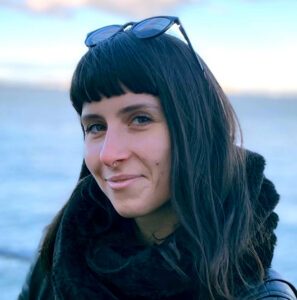 Natalie Very B.
Natalie Very B.
IN VIEW Installation: Our Unconscious
Instagram | Website
About the Artist: Natalie Very B. (she/her) is an award-winning Polish-Canadian illustrator, muralist, and Registered Psychotherapist (Qualifying). Having grown up in a country with a strong patriarchal regime and a social system based on inequality, she strives to make public art that promotes feminist values, self-acceptance, and anti-oppressive practices. As an immigrant who for many years did not feel like she belonged anywhere at all, she found solace in painting colourful landscapes inspired by the soothing quality of nature in Canada, her second home.
Tell us how you relate to the theme “The Space Beneath Us”: Either a story of home, what wilderness means to you, about a memory that effects your/your art to this day, or a little about your roots and just how deep they can grow.
The story that I’d like to tell is of my life-changing trip to British Columbia last year. It was a tremendously impactful experience to witness the wilderness, nature untouched by human hands, so peaceful and thriving. I fell in love with the tall coniferous trees, the moss on the ground, and the perfect silence of the forest. It felt as if I had started to sprout, grow roots deep into the Canadian soil, finally belonging somewhere, like the ferns around me. The luscious green of the nature and the cold, clear ocean water made me feel at home for the very first time. I spent hours walking by the rivers and creeks meandering in the happy landscape. This short yet meaningful trip to the calm island of Victoria allowed me to spread my wings and bring a lot more light and colour into my artwork.
Trotter Brothers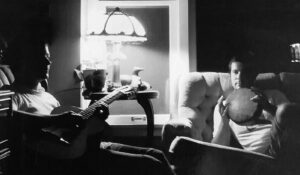
IN VIEW Installation: Duration
Instagram | YouTube
About the Artists: Adam Trotter (he/him) is a member of the Flick the Switch Artists Collective. He has previously shown work in the Power Plant Gallery and the Cambridge Art Gallery. Chris Trotter (he/him) is an experimental musician and multimedia artist whose recent work includes mixed video loops, traditional animation, and video effects with idealized soundscapes.
Tell us how you relate to the theme “The Space Beneath Us”: Either a story of home, what wilderness means to you, about a memory that effects your/your art to this day, or a little about your roots and just how deep they can grow.
The city is an ecosystem even if it doesn’t look like one, hidden under foot with nature waiting in our histories and our futures.
As brothers, we grew up with a healthy dose of boreal life, with camping, canoeing and hiking trips and the occasional farm work. It can be easy for us to regard city life as the antithesis of nature and it can sometimes be hard for us to see the natural side of our city’s eco-system as it is so often buried beneath asphalt, under layers of our making.
Within the city, our accidental encounters have the power to shake us out of this bias: when we stumbled upon a deer feeding in the Don Valley, or watched a hawk attempt to steal a chicken from the Riverdale Farm.
But the more important perception shifts tend to arrive with subtlety where city and nature are no longer held apart. Usually this happens on the micro level, seeing the extent of life underneath a single weed, or the realization that the wildness of the Leslie Spit springs from the debris of demolished buildings, or watching moss grow on an old telephone pole.
These shifts remind us to care for the land and help us to see the natural life of our city, what grows around us and what we leave behind.
 Vridhhi Chaudry
Vridhhi Chaudry
IN VIEW Installation: Unwrapping the unhappy
Instagram | Website
About the Artist: Vridhhi Chaudhry (she/they) is an Indian artist, based in Toronto and holds a MFA in Interdisciplinary Art, Media and Design from OCAD University. Her works have been exhibited across India and Canada.
As an arts based researcher and maker, Vridhhi draws from personal narratives and embodies performance art. Her work honors the resilience of victimhood and survivorship and emphasizes on trauma bodies finding ways to bloom in gloom. She urges her viewers to reconsider their relationship with trauma. Making note of oppressive structures, Vridhhi attempts to creatively open up spaces for colonial healing.
Tell us how you relate to the theme “The Space Beneath Us”: Either a story of home, what wilderness means to you, about a memory that effects your/your art to this day, or a little about your roots and just how deep they can grow.
Wonder doll
There is something
I want to tell
That is now a wound
My body feels numb
So, I break my dolls
Am I just doomed?
Every room taken
So, I find myself a wall
And my soul marooned.
It was Christmas, which also happens to be my parents’ anniversary, a special occasion for the family to celebrate. I was seven. I eagerly looked forward to Santa more than my parent’s anniversary cake. That night I went to bed early, wishing for a doll. How cliché! I took pride in my doll collection; I never discarded the broken ones. I felt the cracker of the gift wrap next to my pillow, and I went back to sleep, relieved that Santa had paid his visit. When I woke up the following day, my present wasn’t present. I couldn’t have imagined it. So where did it go? I went around the house looking for my parents. Instead of wishing them, I asked them if they had seen my gift from Santa. They casually asked me to go back to bed while they made their calls to Santa. I was awake and awaiting Santa. How could I sleep?
While pretending to sleep, I heard my parents murmuring and hushing. Was Santa here? I tiptoed to the door and caught my father red-handed, dressing up my mother as Santa. Boom! Came crashing all my Santa fantasies. I was seven when I realized that Santa was not real. But it was the present that I will remember for a lifetime. My parents didn’t get me a doll, but parts of many dolls I had to assemble myself. We spent the entire day making our dolls, knees for arms and thighs for palms. I didn’t have to break dolls anymore. Undoing was now romanticized as my body’s love language.
In my artistic practice, I find myself returning to the act of undoing. So much is carried and stored in our bodies. It has been essential to recognize my childhood wounds associated with grief and find my way back into the present lived reality. My behavioral patterns as a child are now critical methodologies in my art practice that help me understand and express myself. We are remade in times of grief, broken apart and reassembled. Through grief, we can connect with our deepest selves, which undermines the ground beneath us, turning it to quicksand. It makes us hollow so we can open to what is emerging in the space within us.
Steph Cloutier
IN VIEW Installation: How They Run Deep
Instagram | Website
About the Artist: Steph Cloutier (she/her) is a Tkaronto/Toronto based Francophone artist working in textiles, paper, video, and installation. Her practice explores themes of memory, reciprocity, and repair; utilizing hand embroidery, mending, natural dyes and papermaking to create her 2D and 3D artworks. Her current body of work focuses on her fascination with urbanity, nature, and our existence within those spaces. She received her BFA with Distinction in Sculpture and Installation from OCAD University and has exhibited her work locally and nationally. She has been awarded residencies in Toronto, Canada and Naples, Italy. She is currently an artist-in-residence (Textiles) in the Craft & Design program.
Tell us how you relate to the theme “The Space Beneath Us”: Either a story of home, what wilderness means to you, about a memory that effects your/your art to this day, or a little about your roots and just how deep they can grow.
I’m lucky to have grown up near urban forests, creeks and rivers. These areas offered exciting possibilities for my young imagination to run wild and explore. As an adult, I’m still drawn to these hidden gems, fascinated about what has disappeared as this city has grown. This curiosity has extended into my art practice where I try to re-imagine hidden spaces to reconnect to what is lost. Understanding our city’s history of expansion and development means uncovering what has been hidden in plain sight. It can also put a spotlight on what can be an opportunity for awareness and appreciation.
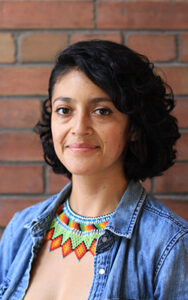 Monica Gutierrez
Monica Gutierrez
IN VIEW Installation: Suspended Animation, (Not All Shadows Are Dark #3).
Instagram | Website
About the Artist: Colombian-born, Toronto-based visual artist, Monica Gutierrez (she/her) is a Visual Arts graduate (York University) known for her groundbreaking projects at the intersection of art and physics that play with space, light, and eternal motion. In 2019 Monica presented an interactive “infinite” collaborative mural project called Revolutions mural at Nuit Blanche Scarborough. Throughout the pandemic, Monica created an interactive multi-coloured light piece for her neighbourhood entitled, “Not All Shadows Are Dark” with the support of the STEPS Initiative and East End Arts. Monica has also directed several documentaries focused on the power of the arts to propel social justice resistance and movements. Her work has screened in Canada and abroad.
Tell us how you relate to the theme “The Space Beneath Us”: Either a story of home, what wilderness means to you, about a memory that effects your/your art to this day, or a little about your roots and just how deep they can grow.
I am passionate about creating pollinator gardens, transforming homogeneous grass lawns into thriving, diverse ecosystems of native perennial flowering plants. Native pollinator species make these gardens their home, restaurant, and overwintering shelter. They burrow in wood, dig under stones, make cocoons out of perfectly round leaf cut-outs, and use Fall leaves to keep warm. Although some of these species are on the endangered species list, their resilience is impressive.
For me, “The Space Beneath Us” curatorial vision was a way to showcase how the species on this land preserve themselves through connections to the soil. The animals featured in my installation all engage in some version of suspended animation underground; a period of self-preserving inactivity. Without our knowledge, thousands of beings are constantly taking pause under our feet throughout all seasons, suspending their lives, and then emerging when conditions allow them to thrive again.
In a parallel scenario, human beings across Toronto have suspended their lives for the last few years and are now emerging from this period of forced inactivity and pause. We can feel comforted by the resilience of these species, and by their judgment on knowing when to take care of themselves, when to take a break, when to return to life.
Sarah Imirsek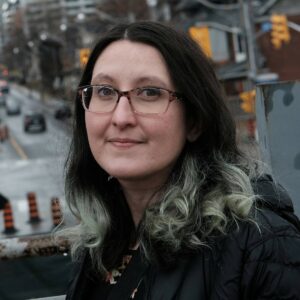
IN VIEW Installation: Unconscious Collective
Instagram | Twitter | YouTube | Website
About the Artist: Wave whisperer. Artist and coder in Toronto. (11 year resident of East Danforth). Previous career as a programmer making educational games. After coming to a halt grieving the loss of a loved one and processing complex trauma, Sarah Imrisek (she/her) found grounding and new inspiration through reconnecting with expressive art. Now she makes art in the streets and with the community, including interactive media art installations, live coding performances, art workshops, murals, and canvases. Her style is colourful, hallucinatory, and rooted in the natural environment. Drawing inspiration from avant-garde art and liberation movements, her practice explores the potential for creative play to bring us together and assist us in imagining new possibilities for ourselves, our communities, our society, and our relationship with the land.
Tell us how you relate to the theme “The Space Beneath Us”: Either a story of home, what wilderness means to you, about a memory that effects your/your art to this day, or a little about your roots and just how deep they can grow.
I promised the land:
I am yours, and I will return to you.
I didn’t deliberate
I was alone by a lake at night
and the promise spoke itself out of me
admitting the bare fact
that my soul felt bigger there
than in the magnificent metropolis.
If it takes my whole life to come round
I am hers and I will return to her.
Many of my roots are tangled and broken. My connection to my family tree is interrupted by adoptions and early deaths. My father was a preacher who lost his faith when I was ten years old, and subsequently I, my mother and my sister also left the church that we grew up in. I moved around a lot and lived many places growing up and often felt like an outsider.
Since I first got involved in community arts, I have been asking myself: who is my community? Who do I represent? Where do I belong?
The one place I have always felt I belong is in nature, which reminds me of my deep interconnection with a vast family that includes the whole planet and even the stars. Trees, wildlife, sun, wind and waves feature heavily in my art as both grounding and uplifting presences. And art has likewise proven to be a communal language that can connect me with people from every walk of life.
When I was five years old in Bancroft, Ontario, a traveller stopped and asked to park in our driveway for the night. His small vehicle was pulling a little canvas covered wagon and the canvas was covered with drawings! I was enchanted. Before continuing on the next morning, he pulled out a black Sharpie and asked me to draw an elephant on his wagon. I didn’t know how to draw an elephant, or why he chose that, but I felt so proud to contribute to his travelling art gallery that I bravely muddled through with the commission. This is my earliest art-related memory: a stranger inspiring courage in a budding artist with a community art project. I hope to keep passing that gift forward wherever I go.
 Andria Keen
Andria Keen
IN VIEW Installation: Once a Tributary: An Homage to the Tenacity of Small’s Creek
Instagram | Website
About the Artist: Andria Keen (she/her) is completing her BFA in cross-disciplinary Life Studies at OCADU, in Tkaronto. Andria returned to the pursuit of studio work following over a decade dedicated to raising her children and running a home based visual art program in East York.
Her works engage with themes of temporality, cyclicality, inclusion, and the natural world. Andria’s practice incorporates: painting, photography, photogrammetry, analog and digital collage, clay, bronze and mixed media sculpture. She utilizes abstraction, figuration, and narrative themes to engage us in questioning our place in relation to both deep and future time as well as ourselves.
Tell us how you relate to the theme “The Space Beneath Us”: Either a story of home, what wilderness means to you, about a memory that effects your/your art to this day, or a little about your roots and just how deep they can grow.
Few things in this world are certain or clear except history, which is often buried or blatantly paved over. When I think of ‘The Space Beneath Us,’ I think of what has been and what will come. I think of the trials, tribulations, trails, and tributaries that lay beneath the surface of the land and people. What a rich, beautiful, tangled mess exists beneath the surface!
In the same way, a complex map of roots and mycelial infrastructure exists beneath our feet, so much story, feeling and history exist beneath the surface of each person and each place.
So that we can move forward from a place of knowledge to honour history, the now, and future now, what lies beneath us physically and personally sometimes needs to be excavated, examined, and honoured.
I come from two places. One paved in asphalt, the other a peaceful wilderness. When I see a line of tar running wild and soft through concrete, it brings my heart joy because it reminds me of a river, which reminds me of the healing power of wilderness. Since birth, I have had the privilege of escaping to a cottage every year for small but heavenly stretches of time. This experience has given me perspective on the benefits of a natural environment. Its presence within a cityscape provides a vital oasis. This line of thought lies beneath what will be my installation, an homage to Small’s Creek, what it has been, what it is and what it can be.
Noor Khan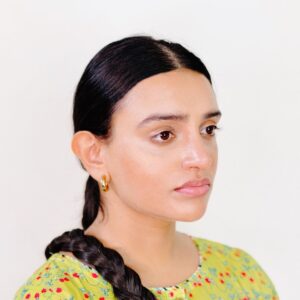
IN VIEW Installation: Revelations
Instagram | Website
About the Artist: Noor Khan (she/her) (b. 1994) is a community-engaged artist, art director and producer. She is involved with art production using a variety of mediums and surfaces, specific to the place and purpose of the work. She was raised in Scarborough (a suburb of Toronto), born in Saudi Arabia, with roots in South Asia. Due to constant migration and nomadic Pashtun ethnic lineage, she was often a subject of surveillance between and within national borders and grew up lacking a consistent communal experience and privilege to maintain relationships with land and people. As a result, Noor’s creations are experiences dealing with the circle of life, informed by geopolitics. As a migrant child, Noor was able to experience different societies and became interested in the design of socio-political structures— the physical components that provide commodities and services essential to enable, sustain, or enhance societal living conditions. Noor’s artwork and arts-based research examines various art and cultural practices, and their role in creating and sustaining environments. She holds an M.F.A in Community Arts and a Certificate in College Teaching of Art from Maryland Institute College of Art (MICA), and has a B.A. in Community Development from the University of Toronto.
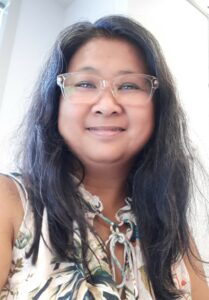 Nancy Lalicon
Nancy Lalicon
IN VIEW Installation: Jupiter’s Beard (A Meeting of the High Up and the Deep Down)
Instagram
About the Artist: Nancy Lalicon (she/her) studied Sculpture at the University of Victoria, Emily Carr College, and Concordia University, Montreal where she obtained her MFA. She discovered the art of making realistic paper flowers in early 2020 for an International Women’s Day event. She’s drawn to making flowers with lots of details such as agapanthus, dogwoods, and thumb-sized violets with roots. She has since shared the art of making paper flowers with seniors, youth and children across the GTA.
As a visual artist Nancy Lalicon splits her time between working as a data analyst and continuing her art practice. She combines a love of making with an interest in data analytics, information theory and a curiosity of theoretical physics. Crafting has always been part of her repertoire as an artist. It has been integral to her making process and informs the techniques she uses to make sculptural work. She currently juggles raising two kids and a cat, while continuing her creative practice in East York.
Tell us how you relate to the theme “The Space Beneath Us”: Either a story of home, what wilderness means to you, about a memory that effects your/your art to this day, or a little about your roots and just how deep they can grow.
As a paper flower artist I’m interested in the roots of a flower because it’s the element that is unseen and yet anchors and sustains the plant. The imagery of roots connotes the grounding of our lives with the past, with our personal histories and the cultural histories we live in and through.
As a first generation Filipino Canadian my roots began with my Filipino heritage. Pancit, stove grilled white fish, karaoke, ghost stories and balikbayan boxes – these are what informed my roots as I was planted into becoming Canadian. And as a Canadian I’m still learning the history and roots of this country – learning about turtle island whose stories began thousands of years ago with the first indigenous settlers and whose current residents have their roots to contend with and learn from.
Jungle Ling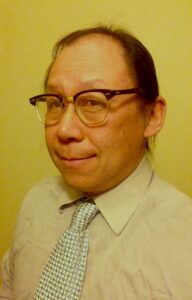
IN VIEW Installation: Petroleum Imprints
Instagram
About the Artist: Jungle Ling is a Canadian artist based in Toronto, Ontario. He was born in Taiwan of Hakka heritage and was raised in Niagara Falls, Ontario from the mid 70’s through the early 80’s. He did have a brief career as a Certified Steel Fitter in Hamilton prior to attending Brock University as a mature student and subsequently settling in Toronto in the late 80’s to attend George Brown College followed by York University. Although he had excelled in the arts throughout his years in public schools, it was his role as a counsellor and art program facilitator at a First Nations’ recovery lodge in Toronto in the late 80’s that generated the spark to pursue his own art unapologetically. His artwork, whether they are paintings, public sculptures or murals, often reflect his values and life experiences along with the connections made particularly with the everyday people, minorities and the marginalized. Examples include the hundreds of impromptu portraits drawn of people from across Canada and elsewhere over the years of criss-crossing the continent on a bicycle. The subjects and materials chosen for his sculptures also reflect the discarded, hidden and overlooked elements in society.
Tell us how you relate to the theme “The Space Beneath Us”: Either a story of home, what wilderness means to you, about a memory that effects you/your art to this day, or a little about your roots and just how deep they can grow:
The mammoth(s) used in this exhibition was originally created in the Yukon several years ago while reflecting on the concept of the buried histories we tread on often without any awareness. The origin of the idea was born in Dawson City where gold miner friends would occasionally unearth frozen mammoths from the Permafrost. Much of the internal armature used to construct this paper mache mammoth were mesh and fence pieces salvaged from local dumps. Often, our buried pasts are just memories that have faded with time such as the mammoths which used to roam throughout the Americas. Some of the buried pasts are of our intentional acts in hiding our unwanted items. Dumps all across this country are full of such. Many of our neighbourhoods have buried stories with many more in the making in our future yet to be build communities to occupy the spaces beneath us.
I hope this installation brings enjoyment as well moments of reflection for us to think about the unseen occupiers of the spaces below.
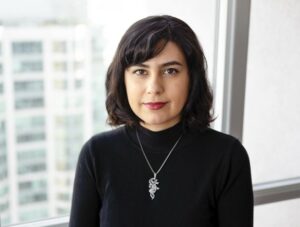 Marzieh M. Miri
Marzieh M. Miri
IN VIEW Installation: Walking with the Invisible
Instagram | Website
About the Artist: Marzieh M. Miri is a Toronto-based documentarian. She has an MFA in Documentary Media from Toronto Metropolitan University(former Ryerson). Her research and creative practice explore the notions of place, land and environment through photographic mediums. She is especially interested in practice-based and sensorial approaches that explore humans and their environment as a united existence. Winner of Ontario Art Council grants has exhibited her art projects in Iran, France, Austria and Canada. She has also worked as an architect, professor, writer and critic and has published in international journals and presented in conferences and courses in Canada, England and Iran.
Tell us how you relate to the theme “The Space Beneath Us”: Either a story of home, what wilderness means to you, about a memory that effects your/your art to this day, or a little about your roots and just how deep they can grow.
Shafiei Kadkani, a Persian poet, expresses a desire: ‘I wish humans could take their homeland with them wherever they liked, the same as violets in soil boxes’. However, it is not the case for humankind. Humans feel homesick or nostalgic when they leave their home. ‘Nostalgia is yearning for aspects of one’s past, a yearning that may include one’s homeland’. it takes years for an immigrant, like me, to overcome nostalgia. Walking while I actively look and listen is a way I practice to create art and at the same time create a sense of belonging to the new place I’m living in, and a way to grow new roots.
Erin Poole
IN VIEW Installation: to grow an armour and a prayer
Instagram
About the Artist: Erin Poole (she/her) is a dance artist of European settler ancestry, based in Tkaronto. She has collaborated on and performed the work of many esteemed artists in Canada and has toured internationally. She has been a company dancer for several seasons at Toronto Dance Theatre: Artistic Director Andrew Tay, as a company dancer.
As a solo artist Erin often explores themes of memory, care, and kinship. She has a rich history of working collaboratively with artists from a wide spectrum of mediums, with numerous projects in film, visual, comic/narrative, theatre, writing and music. She has been nominated for four Dora Mavor Moore Awards.
Tell us how you relate to the theme “The Space Beneath Us”: Either a story of home, what wilderness means to you, about a memory that effects your/your art to this day, or a little about your roots and just how deep they can grow.
At the onset of the pandemic, I was able to move into my grandmothers’ home in Scarborough and spend intimate, caring and confronting moments with her as she approached the end of her life. Reflecting on this time now, I realize I was inside the wilderness of love and loss. The effects of our time together continue to ripple through my art and my body. I continue to create and search for the moments in movement where I can experience both softness and strength.
Naz Rahbar
IN VIEW Installation: A forest
Instagram | Website
About the Artist: Naz Rahbar (she/they) is an Iranian born Tkaronto based multidisciplinary artist with drawing at the core of her practice. Her work is often narrative based and explores the figure. Considering bodily identity as primarily relational through various concepts, such as body knowledge, body and land, bodies and borders and bodies as borders. Naz graduated with a BFA from OCAD University in 2009. In addition to exhibiting work, they have been active in arts education, socially engaged practices, and community arts in Tkaronto (www.art-cave.ca), and across the GTA since. They completed a Bachelor of Education with a Fine Arts focus in 2012, and an MFA at York University in 2019. Naz currently teaches in Art Fundamentals and Illustration at Seneca College, and in the department of Visual Studies Art and Art History joint program at University of Toronto / Sheridan College.
Tell us how you relate to the theme “The Space Beneath Us”: Either a story of home, what wilderness means to you, about a memory that effects your/your art to this day, or a little about your roots and just how deep they can grow.
What you see is a crowd. Why they have come together is unknown. My thoughts around this piece have changed over the past few years, which is encapsulated in the drawing itself, and varied gestures. It has traveled with me from studio to studio, and home to home. I have worked on it during and between projects, in still moments of my practice, pre and post covid. The meaning of a crowd itself has shifted for me during this time. As have many things in the world.
The moment a crowd comes together in celebration, grief or protest, holds a lot of power. In those moments we are united, closest to nature and each other. In those moments like other living things, we exist together as a whole, perhaps without an ego, together like cells. In these moments we are like trees in a dense forest, together and strongly rooted. Yet somehow these moments are also black and white. Not everyone is at the same celebration, or protest. A single tree without its forest family is more vulnerable, a tree without roots to help them communicate is more fragile. An old growth forest is strong and full of diversity, knowledge and community. In these moments we are like trees in a dense forest, together and strongly rooted.
Sarvenaz Rayati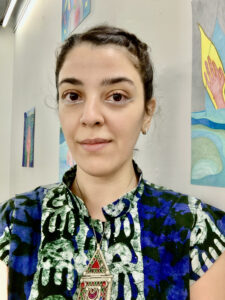
IN VIEW Installation: The Space Beneath Us
Instagram | Website
About the Artist: Sarvenaz Rayati (she/her) is a multidisciplinary artist based in Toronto. She received a BA in painting and BA in visual communication from Art University in Tehran. She has exhibited her work internationally and she makes public art installations in the form of light sculptures and mosaic murals.
“Storytelling has always been my main motivation to create art. Heritage, the self, path, nature, the act of seeking—these are all recurrent themes in my work. I’m inspired by Persian miniature & literature, comics, and life around me.”
Tell us how you relate to the theme “The Space Beneath Us”: Either a story of home, what wilderness means to you, about a memory that effects your/your art to this day, or a little about your roots and just how deep they can grow.
Memory of my camping trips in Iran, the beautiful mountains, hills, trees and flowers of that land have had a deep effect on me and my practice. Whenever I am in nature, I feel at home.
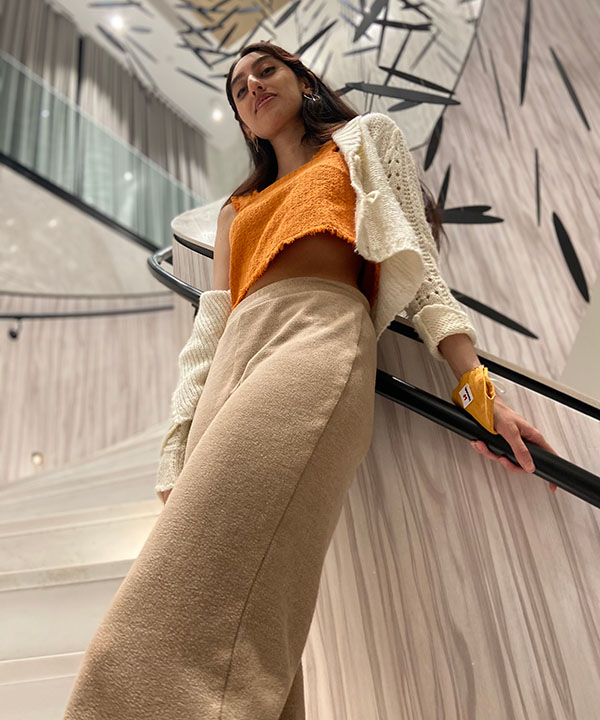 Riya Razdan and Zen Alladina
Riya Razdan and Zen Alladina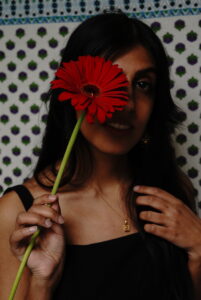
IN VIEW Installation: const(i.e.)llations: X
Riya: Instagram | Website
Zen: Instagram | Twitter | Website
About the Artists: Riya Razdan (she/her) is a UX/UI designer and illustrator who majored in Cognitive Science with a focus on human-computer interaction at the University of Toronto, earning a Bachelor of Science with Distinction in Honours. Her work —both technical and creative—explores interconnectivity, technological accessibility, and escapism. She was a finalist (500+ entries) for Adobe’s International Creative Jam Competition in 2020 and received an Honorable
Mention (2000 entries) for the Annual Adobe Illustration Awards in 2019.
Zen Alladina (she/her) is a writer, poet, and tea sommelier living on the Treaty 13 land known as t’karonto|Toronto, Canada. She is the 2022 winner of Toronto Art Bar Poetry’s Discovery Night, with writing appearing (or forthcoming) in projects from Solarpunk Magazine, Asian American Writers’ Workshop, UKAI Projects, Soap Box Press, and more. She writes stories that draw from (yet dream beyond) history, re-imagining the ancestral to contextualize the Speculative.
Riya is of Kashmiri descent. Zen is of Kutchi descent. Both come from South Asian regions with their own distinct cultures and languages—but no alphabet.
Tell us how you relate to the theme “The Space Beneath Us”: Either a story of home, what wilderness means to you, about a memory that effects your/your art to this day, or a little about your roots and just how deep they can grow.
Zen Alladina:
I grew up near an urban river valley, so that imagery always finds its way into my art: a flow of natural force, older than the city that grows around it. The landscapes that inspired my ancestors would look unfamiliar to me if I saw them myself, but I like to think that there must be some parallel in the scenes that spark my imagination: some reflection of my lineage buried in my internal landscape that finds its way into story.
Riya Razdan:
Even when I can’t see my roots, I feel their presence. Through the chai my mother makes, grounded with the leaves that my grandmother gifts all the way from India. Through the small languages that slip in conversations. Since our alphabet was burned, mainly only older generations fully speak our local dialect. Because of that, it feels even more special whenever someone from my generation or younger repeats the same words, breathes life back into our present culture so that it’s not stuck in history. Similarly through art, we can breathe a new life back into what we thought was fading away. I may not be standing on the same land that my elders grew up on, but I can still look up at the stars in the night sky that they grew under, and share the space beneath us together.
Tennesha Skyers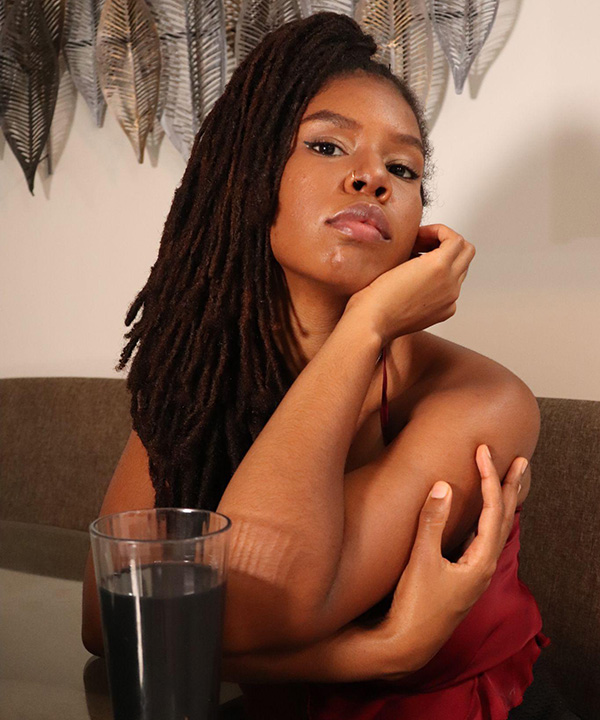
IN VIEW Installation: It’s Getting Hot in Here
Instagram | TikTok | YouTube | Facebook | Website
About the Artist: Tennesha Skyers (she/her) (b. 1994, Toronto, Canada) is a multidisciplinary artist using painting, video, photography, and digital art to create art. She makes art to discuss black, indigenous, queer, and environmental issues. Her art is inspired by history and lived experiences. Her work has been included in solo and group exhibitions nationally and internationally. Her work is permanently collected by musician T.I. in his museum Trap Music Museum, the Canadian Federal Government Office, Office of the Superintendent of Financial Institution, and others. She works with organization Myles Ahead to help change the mental health system across Canada. She is also a philanthropist donating art supplies to youth nationally and internationally.
Tell us how you relate to the theme “The Space Beneath Us”: Either a story of home, what wilderness means to you, about a memory that effects your/your art to this day, or a little about your roots and just how deep they can grow.
My roots go back to Jamaica where my family was born. But I was born in Canada, I am the first Canadian born in my family. Being born in Canada has given me many unique perspectives, such as a unique black experience where black women are treated fairly and equally. My experience growing up in Canada has allowed me to live a life without many hardships and with many equal opportunities. This is why it breaks my heart to see and hear how Indigenous people are called Indians, are told to forget things that are still happening to them such as their children being forced into a foster care system, racism in the health care system, missing and murdered Indigenous women and girls, boiling advisories, misconduct from RCMPs, rape, murder, racial profiling while shopping, and so many other injustices like pipelines and residential schools. How an immigrant can come to this beautiful land and have clean water to drink while an indigenous reserve is literally stripped of theirs in 2022 is beyond me.
 Sara Vargas Nessi
Sara Vargas Nessi
IN VIEW Installation: Memories
Instagram | Website
About the Artist: Sara Vargas Nessi is a fine artist who captures natural light and shadows over her paintings. She moved to Canada in 2013 from Venezuela. In 2016, she graduated from Fine Arts Studio at Centennial College. Since then, she has created impactful images with paint, sunlight, and shadows. Sara is also an actress, dancer, and filmmaker. She is constantly exploring new ways to combine Fine Arts with Performing Arts.
Sara is the artist behind the two-story mural at Centennial College, Story Arts Center. Her work has been shown in several groups and solo exhibitions across Canada and Venezuela. She is currently working on “Shadows Project”, an online social media exhibition that explores the connection of Sara’s images with the natural and city landscape of the City of Toronto.
Tell us how you relate to the theme “The Space Beneath Us”: Either a story of home, what wilderness means to you, about a memory that effects your/your art to this day, or a little about your roots and just how deep they can grow.
Growing up, I was surrounded by the colourful landscapes of Caracas, Venezuela. From the sunrises going to school to the sunsets after having eaten a delicious arepa at dinner. Caracas is a valley and the mountain that separates the city from the sea is called El Avila. When I was a teenager, I remember people talking about how El Avila changed colours depending on the light variations during the day. This fascinated me and I asked myself why I have not paid attention to this before. I used to see El Avila every single day and had not noticed this. I guess that this made me become extra aware of the things we sometimes take for granted and forget to appreciate.
In Canada, my curiosity for light and colours deepened when I discovered them with new eyes through the changing of seasons (something that I had not experienced before in my life!). My experiences, including the challenges of immigrating to Canada, inspired me to create artwork based on the idea of finding beauty in the ordinary in the form of colour, light and shadows. I wanted to show how important it is to find the light within the shadows as I came to understand that one cannot exist without the other as we only recognize light because we know shadows.
My art is a collection of memories based on life experiences like seeing El Avila change colour throughout the day, moving to Canada, seeing the brightness of a summer morning, hearing the silence of winter, or watching my dad working with tools I now use to build installations. These moments and many more planted little seeds that have grown into roots that run deep shaping my art and who I am today.
Jes Young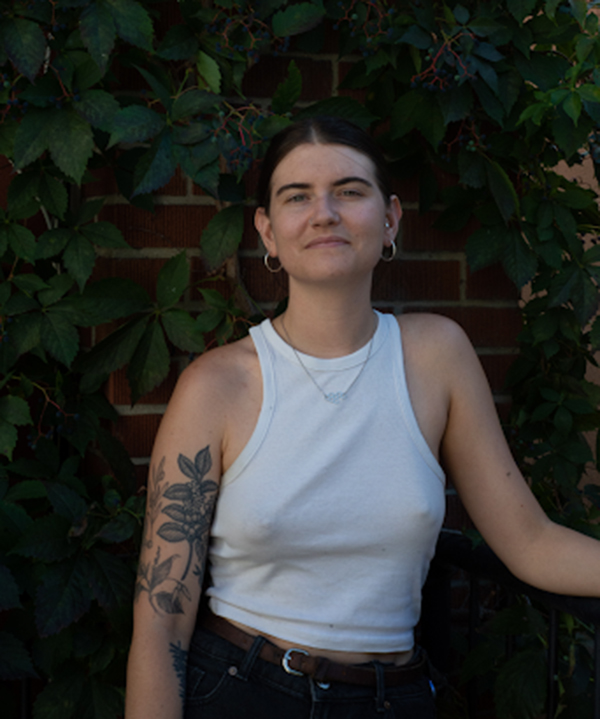
IN VIEW Installation: Won’t you Stay a While?
Instagram | Website
About the Artist: Jes Young (they/them) is a non-binary mixed media sculpture artist and educator based in Toronto, Canada. Their practice investigates alternative uses of space inspired by infestations and repetitive natural patterns. They gravitate to using discarded, abandoned and environmentally conscious materials within their work. They practice fluidity within all things. Young received their Masters of Fine Arts, Bachelor of Fine Arts with Honours, and Bachelor of Education from York University. They have held a guest artist position at York University and have exhibited in multiple group and solo shows in and around Toronto such as the Litter Art Program with A Greener Future (2022) and Something Creative’s Bi Bi Baby Showcase (June & October 2022). Alongside continuing to develop their artistic practice they fabricate artwork for local Toronto artists Erin Vincent and Cybele Young.
Tell us how you relate to the theme “The Space Beneath Us”: Either a story of home, what wilderness means to you, about a memory that effects your/your art to this day, or a little about your roots and just how deep they can grow.
“The Space Beneath Us” is a theme I have been exploring in my recent work that has me literally stopping to look in different places and perspectives. Living in Toronto sometimes it’s tricky to see wilderness and nature amongst endless concrete but if you look down you find a whole new world. With attention drawn upward toward the endless loud construction and skyscrapers I found comfort in finding the local plant life that finds a way to fill in the cracks of the streets and sews the city together. My artwork hopes to highlight these incredible local plants, structures and creatures that do so much for us just below our sightline.
